Content
Technology revolutionizes the traditional way of providing financial services to clients globally. The rapid digital transformation of the financial sector became a popular trend driven by the need to adapt to global influences and shift to a client-based focus. Nowadays, financial solutions must provide reliable security, offer high-level optimization and management of finances, and provide convenience and speed of service. This gives financial businesses a huge incentive to invest in various technology-based fintech solutions.
According to Research and Markets, the global mobile payment market size is projected to reach $12.06 trillion by 2026, growing at a CAGR of 24.8% from 2021 to 2026. According to Statista, the number of mobile payment users worldwide is expected to surpass 1.3 billion in the upcoming years, indicating a significant shift towards digital transactions and mobile-based financial services.
So, if you are starting a new financial business venture or decide to pivot along the road, money transfer app development is one of your proven go-to options.
Having a solid experience in the FinTech niche, we’ve prepared a detailed guide to help you understand how to create a money transfer app and set up the right development process with minimal risk and maximum profit for your business.
What is a money transfer app?
A money transfer app is a system or type of app that allows users to make banking transactions via cashless payment methods with multi-bank and multi-currency options. Users can make payments without using a bank or credit card, manage various money transfers (online and mobile) and exchange currency on the spot quickly and securely.


How does the money transfer app work?
Most online payment applications include a digital wallet so that customers can deposit their funds to later use them for payments: domestic or international bank transfers.
If both parties use the same payment application, they can transfer money by simply identifying the recipient via email or mobile phone number. The transferred amount is debited from the sender’s wallet and credited to the recipient’s wallet.
In case the money transfer application uses a bank account or credit card, the process works as follows: encrypted information is sent to the payment system, credit card issuers, or banks to confirm that the necessary amount is in the sender’s account; after that, the amount is added to the recipient’s balance.
4 types to create a money transfer website
Before you create a money transfer app, you should clearly know your business requirements to choose the type of money transfer app that best suits your needs and the demands of the target audience.
Typically, money transfer apps are divided into two main categories: outward remittance (for money transfers you make outside your country) and inward remittance (any transfer of funds you receive from abroad).
Based on the needs of your business, the most popular types of money transfer apps are as follows:
Person-to-Person (P2P) payment system
A peer-to-peer or person-to-person (P2P) payment system refers to online transactions made between two different accounts through a payment app. P2P customers can make transfers using personal computers, smartphones, or tablets. Also, P2P payment systems are divided into mobile, independent, and online banking services.
- Mobile services – typical examples are Apple Pay and Android Pay, where users can transfer funds to users who use the same mobile service.
- Independent services – a typical example is PayPal, where Visa and MasterCard cardholders can make money transactions through an e-wallet provided by a particular P2P service.
- Online banking services – typical examples are Ukraine-based Privatbank and Monobank. Traditional banks are launching their own mobile and web apps that allow users to send, receive and manage their finances directly through a bank-centric app.
Business-to-Business (B2B) money transfer system
A business-to-business money transfer system is a digital payment method that allows commercial transactions between two separate businesses. A clear example of a B2B payment solution is Stripe. This type of transaction allows one company to buy goods or services from another firm. For example, when one business needs to use the operational services of the other business or acts as an intermediary, selling products produced by other companies.
Digital remittance services
Wise is one of the best examples of a digital money transfer app. Online remittance providers simplify the money transfer process by charging a fee based on the total amount of each transaction. Users only need to register an account with the same digital money transfer service provider to make transfers in a few clicks.
Electronic bill payment services
Electronic bill payment services made it possible for customers of any bank to transfer money from a personal credit or debit card to the public services vendor or department store. This option is a mobile or web-banking solution used for bill payments. These payments are made directly through the national bank-operated payment system or jointly with the government.


Why develop a money transfer app?
The importance of money transfer applications can be understood by definition – a system or application that allows users to make instant payments on the Internet without bank cards and via non-cash payment methods. For businesses, this means complete independence and no additional costs that damage the budget. However, there are other essential reasons why you need to create a money transfer app. Let’s look at them in detail.
Great demand
Over 2.5 billion active users choose money transfer apps to quickly and easily send and receive money almost instantly. Demand for fast and easy one-click payments has grown significantly over the past few years and still outstrips supply. According to the Precedent Research report, the global P2P payment market will reach around $9.87 trillion by 2030. Inspired by market statistics, companies build a P2P money transfer app to tap into this lucrative niche and get ahead of the competition in their segment.
Efficiency
There are plenty of benefits accompanying money transfer app development. If you create a custom money transfer app, you will get a P2P payment app infrastructure that supports all business processes in your organization with fast responses. That makes your business more efficient and improves your overall productivity.
Scalability
Creating money transfer applications is an excellent opportunity to accelerate the growth of your business. Clients may have many financial needs you can quickly meet by implementing a new FinTech solution. All you need is to get your development team together to perform in-depth research on the potential needs of your business.
Profitability
Money transfer app development is a go-to way for many business owners to generate more revenue. While you are developing a finance solution on your terms and best optimized for your business model, you can integrate a subscription-based model to start selling it to other organizations that also need well-optimized finance processes. Besides, the development of money transfer solutions can come in handy for building new business collaborations in the neo-banking segment.
Independence
When you create a money transfer website, you pave your way to complete independence from commercial software to receive access to financial services. Instead, you create custom software tailored to your core business needs and targeted requirements. With it, you are not limited by other software’s terms of use, pricing policies, required updates, and support.
How to create a money transfer app in 7 steps?
You can encounter numerous challenges and pitfalls along money transfer app development: from budget overheads and delayed releases to limited app demand. To cut your risks and help you set up the proper development process, we’d like to share our technical and business know-how to develop a money transfer app.
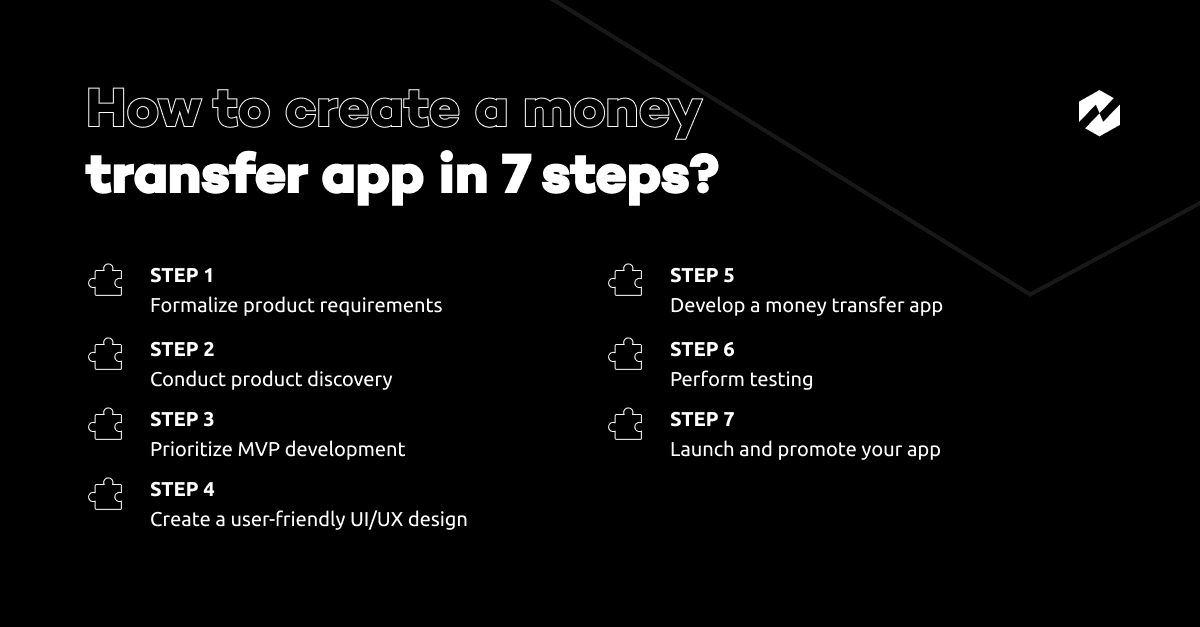

Step 1. Formalize product requirements
To start with the money transfer app development, you should first define your business goals, formalize requirements and sketch the overall product concept. It will become the basis of your project and the so-called material for building a long-term product strategy.
At RewiSoft, we usually assign 1-2 business analysts and other related experts that schedule workshops with our customers to collect all relevant information about the future project, preliminary design specifics, functionality, number of features, etc. We dive into the business context to discover our customers’ main problems and requests to start creating a backlog and move to in-depth product discovery.
Step 2. Conduct product discovery
Each FinTech product has its type, feature set, and functionality scope depending on the market needs, unique business, targeted goals, available budget, and team resources. So, to obtain this data, you will need to conduct in-depth market, competitor, and user research. The data gathered from this analysis will help you:
- Define necessary and nice-to-have features
- Understand design specifics and main features
- Understand who your target audience is
- Create user personas and user flows
- Define business model
- Clarify the pain points your solution will solve
- Create a unique value proposition that will differentiate your app from competitors
- Establish the project milestones, map out further development steps, and set budget
- Agree on a single product concept with all project stakeholders
- Create technical documentation and product requirements specifications
Step 3. Prioritize MVP development
An MVP development is one of the most effective and proven ways to ensure your investments and efforts will pay off in the long run. If you create a money transfer app from scratch – go the MVP route to validate your idea, prioritize basic functionality for an MVP version and decide on the further development steps.
It will also help you decide what type of money transfer application you need to develop (mobile, web, or both) to meet your target demand and user needs best. With only basic functionality and a fixed budget, you can ensure that your idea of a money transfer app is viable and worth building a full-fledged product.
So, building an MVP is essential to:
- Save time and money
- Test your product on real users
- Gather your target audience’s feedback
- Get your first customers
- Identify the list of core and nice-to-have features
- Increase brand awareness
- Attract potential investors
- Get your first return on investment (ROI) if your idea is viable
At RewiSoft, the process is simple: we develop core app features with a simple UI/UX design, test the app, collect feedback, and start implementing the advanced features if the idea is profitable. This approach is the most optimal way to bring you from an idea to a successful product launch in a fast and budget-friendly way.
Also read: How To Create a Minimum Viable Product (MVP)? [Startup Case Studies]
Step 4. Create a user-friendly UI/UX design
We know that great design is a design that meets customer needs and drives conversions. Since users of money transfer apps deal with financial transactions, we prioritize simplicity, transparency, and responsiveness in the UI/UX design.
To get all the design jobs done, we assign 2+ experienced UI/UX designers in the FinTech niche to create intuitive navigation, flawless user experience, and clear visual parts of your application.
The design process at RewiSoft works as follows: once all project specifications are ready, our design team can start creating mockups for your future money transfer solution. We start visualizing the main app features in the identified user scenarios. Our designers develop well-researched customer journey maps that will provide a clear insight into how users will interact with your app and reach their primary goal: transfer money.
Our design team is involved in all aspects of branding, design, usability, and function and creates compelling UX wireframes and prototypes to visualize how the app looks and performs. After that, several options are submitted for testing with real users so that we can make improvements and minor corrections if necessary.
Important tips and design rules from RewiSoft:
- Go mobile-first or make responsive design versions to adapt the application design to different screen resolutions, whether your users access your app through a desktop, tablet, or mobile
- Avoid bright colors, confusing navigational logic, and over-clutter that distract users from the primary task
- Prioritize one-two-click features to make the user experience easier and less overwhelming
- Define clear and logical steps for each user flow to provide clear access to all necessary functions
- Ensure minimum steps in the app navigation
- Balance simplicity with attractive elements
- Add multilingual interface support to reach a wider audience and improve overall UX
Whether you have an existing app or building a new one – we can offer our UX Lab services to ensure top-level usability. We use an Eye Tracker tool to investigate how users engage with the product and enhance overall UX.
Find out more about our related service offerings:
Step 5. Develop a money transfer app
Before you go to the development, you should also choose the approach to create a money transfer website: in-house or software development outsourcing.
In-house development suits enterprise-level businesses with a strong in-house development team with proven experience in the FinTech niche.
Software development outsourcing works well for businesses lacking professional talent to develop a money transfer app. Startups, SMBs, and enterprises can vote for this option to get an experienced FinTech development team covering all phases of the development lifecycle, from initial ideation to final release and maintenance.
If you choose software development outsourcing, RewiSoft can be your reliable choice.
During the development stage, our highly skilled coders implement all the planned features of a money transfer app, including electronic wallets, contactless payments, currency exchange, etc.
The scope of the whole programming work is divided into front-end and back-end development. Usually, we assign 2+ experienced front-enders to convert the designed screens into functioning user sides. The back-enders create the “brain” of the application by implementing APIs, and business logic, managing databases, and integrating other critical services.
The RewiSoft team follows development best practices in this process, including Agile project management and a CI/CD approach to automate new build delivery, testing, and secure deployment. We also prioritize regular code reviews, code quality control, and regular reporting to stay on the same page with all project stakeholders.


Step 6. Perform testing
We focus on continuous testing during the development stage to minimize potential rework later. Besides, when the development jobs are done, we have scheduled multi-level testing to verify the money transfer app’s usability, performance, acceptability, and functionality. We put the results into bug reports and assign developers to fine-tune the app and make necessary improvements.
Step 7. Launch and promote your app
After fine-tuning the functionality, we launch the application for the target audience, collect feedback and make reworks, if necessary. In cooperation with us, you will get follow-up application support and maintenance whether you need to resolve post-release bugs or implement new features or updates.
Also, ensure you promote your app through social media, SEO-optimized content, paid ads, etc. That will help you attract more customers and build an online presence.
Read more on related topics:
How to Create an Online Banking Website [In-Depth Development Guide 2023]
How to Build a Personal Finance App in 2023 [a Step-by-Step Guide]
What features do you need to create a money transfer app?
Every money transfer app should have core features that help end users transfer money, pay bills, make purchases, exchange currency, etc. We recommend building the following features for your money transfer app:
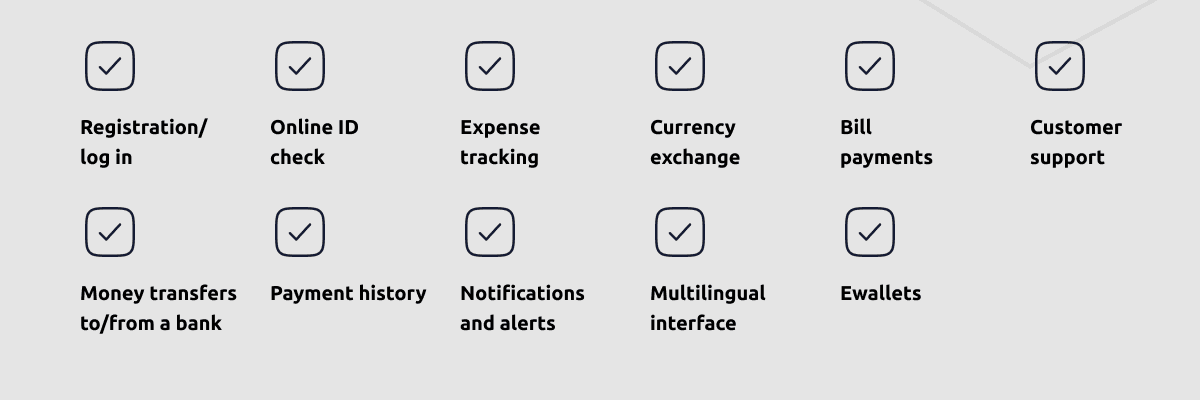

Registration/log in
Your customers should start using your money transfer app without any burden. Since we deal with financial solutions, you should focus on reliable authorization and robust security. The best practice is to implement 2FA and biometric login (e.g., Face ID and Touch ID) to protect users’ accounts from unauthorized access.
Online ID check
An online ID verification prevents your money transfer payment system from fraudulent transactions. An online ID check helps senders to protect their financial data and sensitive information while the recipient avoids scams and frauds. We recommend integrating automatic verification requests and setting cash limits.
Expense tracking
This feature is handy in helping customers manage their finances more effectively. We implement this feature by visualizing expenses and grouping them by category (e.g., bills and utilities, transport, food, etc.), volume, status, location, etc. This approach is a more visible way for customers to optimize their expenses and improve their UX.
Currency exchange
With this feature, customers don’t have to visit currency exchange offices in person. Instead, they can send and receive any currency in just a few swipes and exchange currency between their cards whenever they want through your app.
Bill payments
You can add more value to your customer-centric money transfer app by allowing your customers to pay bills online in a few taps. In addition, you can add an invoice-scanning feature to attract businesses in particular and make your app more attractive to customers and more competitive than other market participants.
Money transfers to/from a bank account
Integrating money transfers to/from a bank account to a money transfer app would enable users to send and receive money transfers within a few seconds and swipes. Using this feature, your customers can make local and international transactions and receive transfers without delays and extra fees. By simplifying the money transfer process, you also drive customer loyalty.
Ewallets
E-wallets allow users to make electronic transactions and store funds and bank details in a payment application. When using e-wallets, your customers can pay contactless, regardless of location. An excellent example of an integrated e-wallet is PayPal’s mobile wallet app.
Payment history
It’s vital to make easy for users to find a specific payment. That will also add value to the seamless user experience. However, you should make this feature easy to understand and fast-loading. This way, you will make your P2P platform more attractive, convenient, and user-friendly.
Notifications and alerts
Notifications and alerts increase usability and customer loyalty. Every activity that occurs on an account should notify users via pop-ups or push notifications. It lets users keep informed about all the actions within their banking accounts. For example, you can update your users about account and wallet changes, new updates, special promotions, and offers.
Multilingual interface
Businesses that start with MVP development are enough to use a single language to represent the app to customers and potential investors. However, in the later stages, adding a multilingual interface will help you to grow and scale your audience worldwide faster.
Customer support
A support system is essential to resolve all customer’s problems and requests and make users feel protected when using your app. A typical support system should include a live chat option and email or phone call support features. You can also create an FAQ section to give users fast answers to commonly asked questions.
Tech requirements for money transfer app development to consider
The success and viability of your money transfer app in the market depend primarily on technical characteristics. Consider the technical requirements below to create a money transfer app with solid security, industry compliance, and decent quality.
Tech stack
To bring your money transfer app solution to life, you should wisely choose the instruments, tools, and technologies to build your app. The required choice will significantly affect the app’s scalability, reliability, and flexibility.
So, depending on the development approach (native, hybrid, or cross-platform), we analyze the tools and technologies and select those that meet your unique business needs, technical requirements, and scalability goals.
For money transfer app development, we usually prioritize the following tech stack:
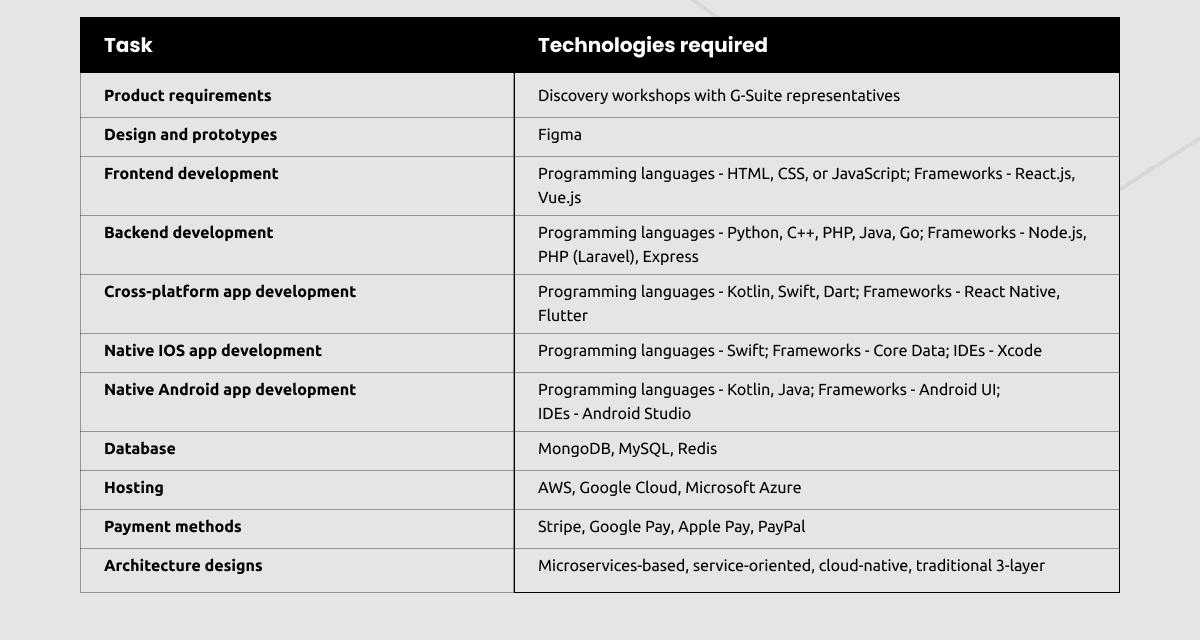

Regulatory compliance
Security and regulatory compliance are on the front line of any application in the Fintech niche. All finance applications are subject to specific regulatory standards related to dealing with people’s finances. The regulations vary by jurisdiction, so your application must comply with Fintech standards in the location where your app will run. It is imperative, as non-compliance can result in civil, financial, or even criminal sanctions for businesses and accountable persons.
Below you can see a couple of examples of authorities by region to deal with legal issues:
- United Kingdom – Financial Conduct Authority (FCA)
- USA – the Office of Foreign Assets Control (OFAC) + depends on the state
- Canada – the Bank Act and FINTRAC
- Australia – the Reserve Bank of Australia (RBA), the Australian Prudential Regulation Authority (APRA), the Australian Securities and Investments Commission (ASIC), and the Australian Competition and Consumer Commission (ACCC)
- European Union – Directive (EU) 2015/2366 + GDPR compliance
- China – FinTech Committee under the People’s Bank of China (PBOC)
Security
Security comes first when we deal with money transfer app development, as such applications not only transfer funds but also report on completed transactions. As such, it is essential to consider all FinTech laws and local regulations, enforce anti-terrorist financing requirements, and prevent money laundering.
At RewiSoft, we use only time-tested and proven methods to protect your customers’ data and finances and prevent fraud and data leakage.
The recommended measures from RewiSoft to best secure your money transfer app:
- Two-factor authentication (2FA)
- Biometrics implementation (Touch ID, Face ID)
- The Payment Card Industry Data Security Standard (PCI DSS) compliance (if you deal with cards)
- PSD2 compliance
- OWASP compliance (for web app security)
- Regular password changes on a schedule
- Setting up identity verification such as Anti-Money Laundering (AML) and Know Your Customer (KYC) procedures
- Data encryption and payment gateway protection
- Embedded session time limits
- Implementation of non-stop transaction monitoring to detect and block suspicious activities
- Regular and encrypted application backups
- Creating a disaster recovery plan
Our experience in money transfer app development
We at RewiSoft have solid experience helping businesses from various business verticals develop goal-specific financial apps that stand out from the competition and generate solid income for their owners. Our developers have experience providing high-quality banking software development services and creating all-in-one banking solutions with money transfer functionality.
One of our success stories was the development of an innovative neo-banking app for children that helps parents remotely control money transactions and allows children to learn financial literacy.
The main requirement for our team was to build an online banking website application with two versions with parents- and children-specific functionality and integrate reliable and secure money transfer functionality.
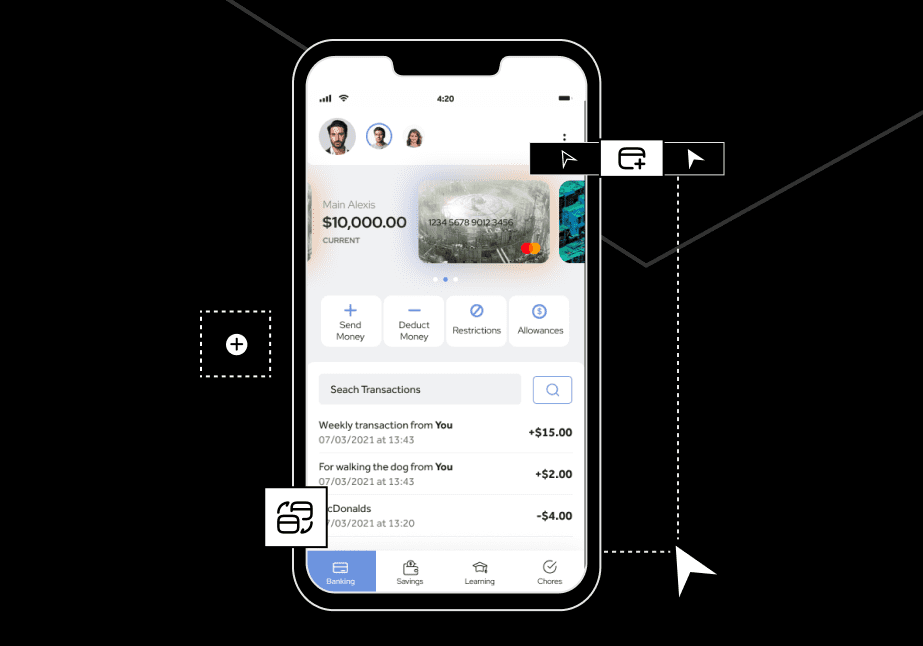

So, after conducting several workshops, in-depth discovery, and business analysis, RewiSoft identified the following challenges for this project:
- Develop a kids-friendly neobanking app with different feature sets that both kids and parents can use
- Set up adequate parental control
- Integrate best security practices to ensure user data’s complete security and safety
- Create an attractive interface design and data visualization with interactive elements
- Design and develop features of online financial literacy training to attract children
The RewiSoft team completed the project tasks on time and developed the following features:
- Special features for kids to create cards, make money transfers, and other financial transactions
- Loan application to allow children to take loans by opening credit cards
- Financial goal-setting feature to allow children to save money by setting a goal in the app
- Tailored features for parents to top up children’s cards, set transaction limits, and create scheduled payments for children
- Parental control feature
- Online education for children
- A built-in calculator for calculating the amount by which parents need to replenish the child’s card
The RewiSoft team successfully released the neobanking application under the client’s expectations, budget, and deadlines. We did more than a typical online banking website solution. We implemented secure money transfer functionality and added interactive visualizations, adequate parental control, and elements of online learning.
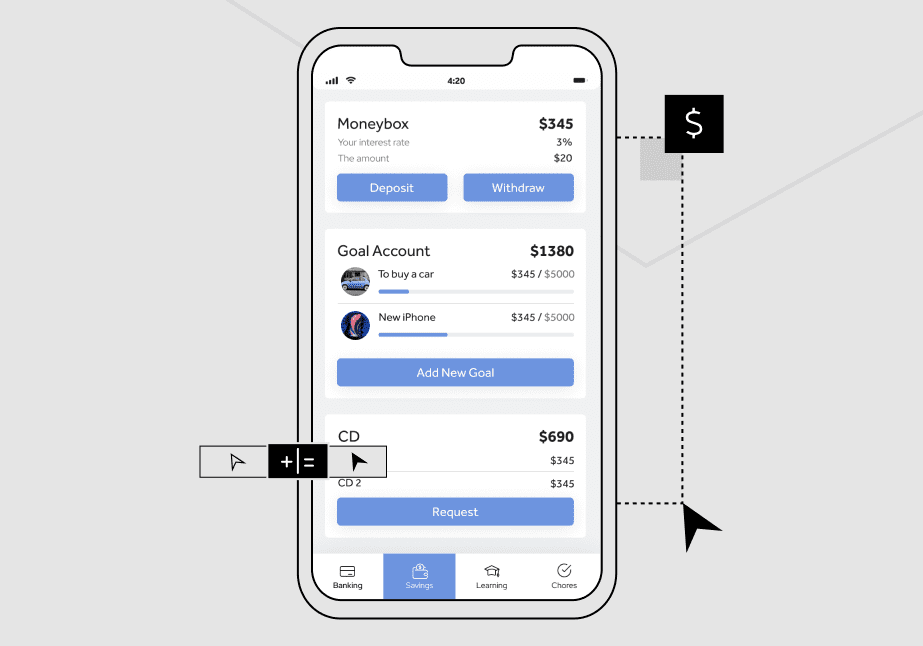

We’ve implemented a two-sided app that allows parents and children to meet specific needs. Children learn how to properly manage money, make financial transactions, and be responsible for finances, and parents can remotely control their children’s transactions.
As a result, handy features, smooth navigation, and gamification elements make this online banking application a top solution for the Neo banking sector.
Learn more about our related service offerings:
Document management software development services
Mobile banking development services
How much does it cost to build a p2p money transfer app?
Many cost-affecting factors will determine your final project budget.
For example,
- The complexity of the UI/UX design
- The number and complexity of app features
- App architecture
- Team expertise
- Team size
- Hiring model
Since each project has its own goals, requirements, and needs, we can calculate the cost more accurately once you share your project details with us. To give you a hint, we’ve estimated the approximate cost to create a money transfer app depending on the region and project stage you need help with.
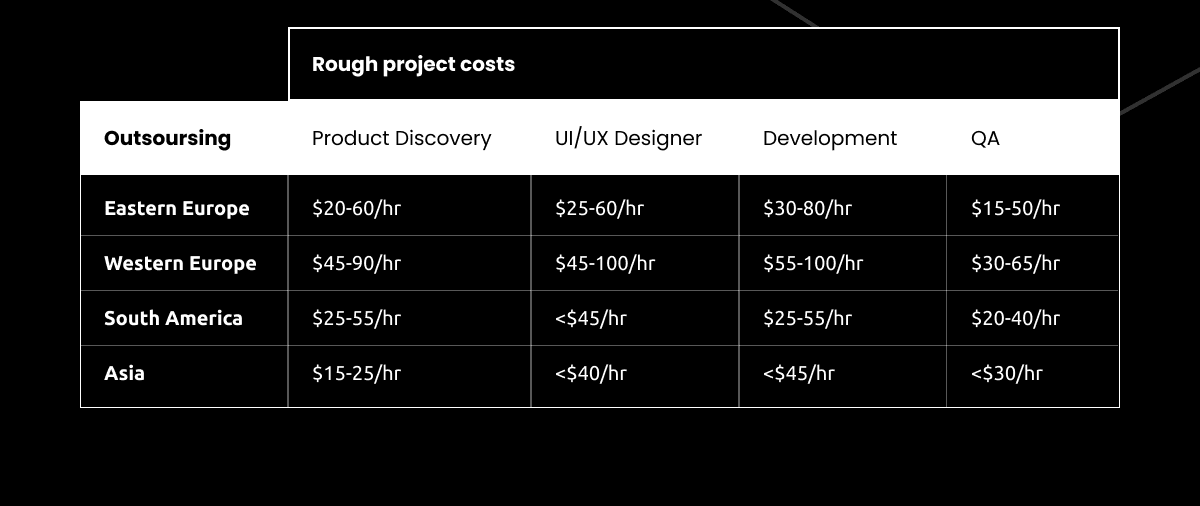

On average, at RewiSoft it will cost from $20,000 to develop an MVP version of the money transfer app. The rest will depend on unique requirements, the size, and complexity of the required features, legal costs, additional third-party services, application maintenance, marketing costs, etc.
How long does it take to build a p2p money transfer app?
The main factors that affect the time it takes to create a money transfer app are the platform you use, development tools, how many customization features you need, and whether you have an in-house team or outsource the software project to reputable agencies.
On average, building a money transfer app can take from 1,000 hours.
Below you can also see RewiSoft’s timeline calculations divided by project stage.
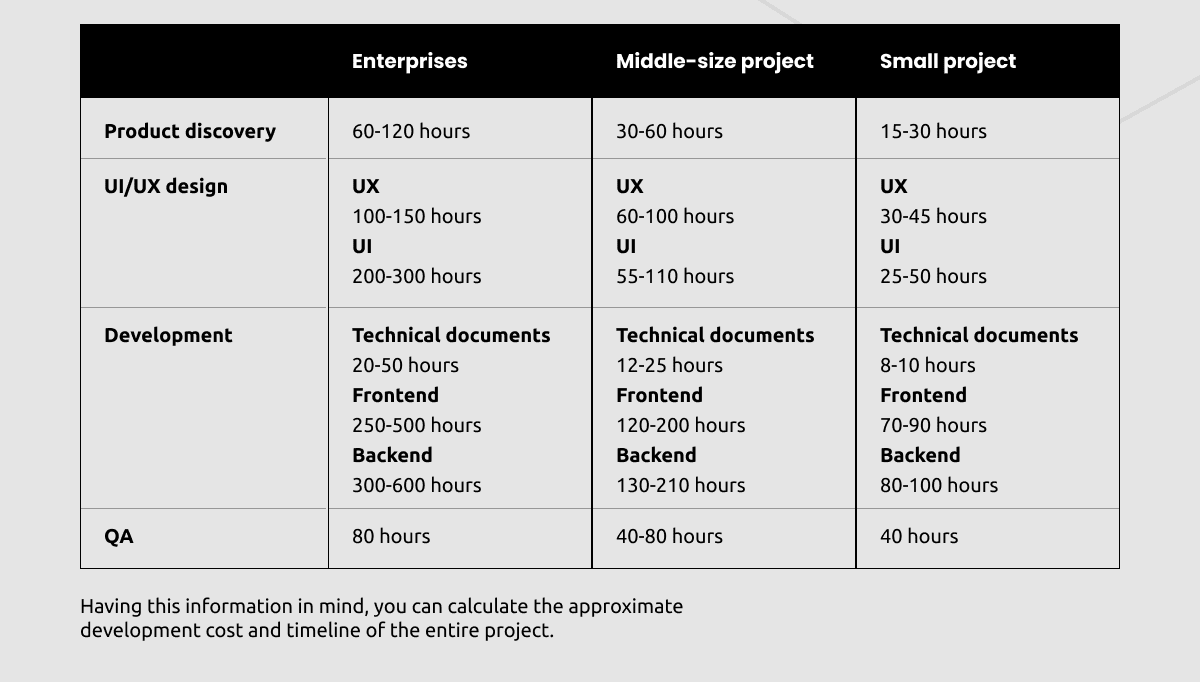

By choosing RewiSoft, you will also get a highly committed team to deliver the project according to the planned schedules. Thanks to Agile methodologies, well-polished development workflows, and proven experience in the FinTech niche, we guarantee our customers a quick time to market with high product quality and solid security.
Estimate the accurate development cost and time by sharing your specific product requirements and needs. Get an estimation right now!
Money transfer app development: summary
The global FinTech sector is moving towards consumer-centric digitalization in giant strides. Whether you launch a new business adventure or modernize your existing business, moving in an online direction will make your business sustainable, profitable, and competitive in the long run – especially if you choose to go off the beaten track with professional experts!
RewiSoft is a money transfer app development provider that offers top financial software development services to make your business idea viable and profitable. Our technical experts know all the ins and outs to help you create a money transfer app based on your requirements and needs.
Considering RewiSoft as your trusted money transfer app development partner, you can:
- Level up your financial services provided to clients
- Modernize ineffective legacy financial systems
- Strengthen application security and ensure reliable, sensitive data protection
- Integrate your financial systems with other apps
- Improve customer experience using top trends in the FinTech niche
- Create a personalized approach to managing financial processes
- Benefit from risk prediction, data analytics, and efficient finance management
Get in touch with us to discuss the potential of your project and share your needs and ideas!







